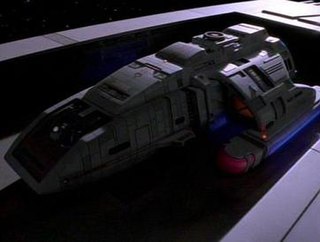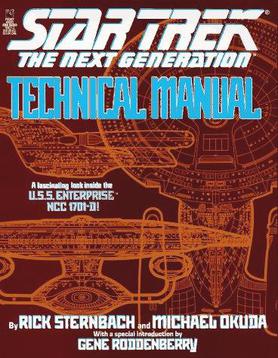Related Research Articles
Enterprise or USS Enterprise, often referred to as the Starship Enterprise, is the name of several fictional spacecraft, some of which are the main craft and setting for various television series and films in the Star Trek science fiction franchise. The most notable were Captain James T. Kirk's USS Enterprise (NCC-1701) from the original 1960s television series, and Captain Jean-Luc Picard's USS Enterprise (NCC-1701-D) from Star Trek: The Next Generation.
In the Star Trek fictional universe, shields refer to a 23rd and 24th century technology that provides starships, space stations, and entire planets with limited protection against damage. They are sometimes referred to as deflectors, deflector shields, or screens. Types of shields include navigational deflectors.
The Star Trek fictional universe contains a variety of weapons, ranging from missiles to melee. The Star Trek franchise consists mainly of several multi-season television shows and a dozen movies, as well as various video games and inspired merchandise. Many aspects of the Star Trek universe impact modern popular culture, especially its fictitious terminology and the concept of weaponry on spacecraft. The franchise has had a widespread influence on its audiences from the late 20th to early 21st century. Notably, Star Trek's science fiction concepts have been studied by real scientists; NASA described it in relation to the real world as "entertaining combination of real science, imaginary science gathered from lots of earlier stories, and stuff the writers make up week-by-week to give each new episode novelty." For example, NASA noted that the Star Trek "phasers" were a fictional extrapolation of real-life lasers, and compared them to real-life microwave based weapons that have a stunning effect.

USS Voyager(NCC-74656) is the fictional Intrepid-class starship which is the primary setting of the science fiction television series Star Trek: Voyager. It is commanded by Captain Kathryn Janeway. Voyager was designed by Star Trek: Voyager production designer Richard D. James and illustrator Rick Sternbach. Most of the ship's on-screen appearances are computer-generated imagery (CGI), although models were also sometimes used. The ship's motto, as engraved on its dedication plaque, is a quote from the poem "Locksley Hall" by Alfred, Lord Tennyson: "For I dipt in to the future, far as human eye could see; Saw the vision of the world, and all the wonder that would be."
In the Star Trek franchise, the Klingon Empire makes use of several classes of starships. As the Klingons are portrayed as a warrior culture, driven by the pursuit of honor and glory, the Empire is shown to use warships almost exclusively and even their support ships, such as troop transports and colony ships, are armed for battle. This contrasts with the exploration and research vessels used by Starfleet, the protagonists of the franchise. The first Klingon ship design used in The Original Series, the D7-class battlecruiser, was designed by Matt Jefferies to evoke a shape akin to that of a manta ray, providing a threatening and instantly recognizable form for viewers. The configuration of Jefferies's design featured a bulbous forward hull connected by a long boom to a wing-like main hull with the engine nacelles mounted on each wingtip. Though a variety of Klingon ships have appeared in Star Trek, their design generally conforms to this style. Most Klingon vessels were physically built as scale models, although later computer-generated imagery was used to create the models. In recent years, many of the original studio models have been sold at auctions.

Runabouts are a fictional class of small, multi-purpose starships appearing in the Star Trek science-fiction franchise, primarily the television series Star Trek: Deep Space Nine, which aired on syndicated television between 1993 and 1999. They served as a means of transport for the crew of the fictional space station Deep Space Nine, in the early seasons of the series enabling storylines taking place away from the station.

USS Enterprise (NCC-1701-D), or Enterprise-D, is a starship in the Star Trek media franchise. Under the command of Captain Jean-Luc Picard, it is the main setting of Star Trek: The Next Generation (1987–1994) and the film Star Trek Generations (1994). It has also been depicted in various spinoffs, films, books, and licensed products.
This article discusses the fictional timeline of the Star Trek franchise. The franchise is primarily set in the future, ranging from the mid-22nd century to the late 24th century, with the third season of Star Trek: Discovery jumping forward to the 32nd century. However the franchise has also outlined a fictional future history of Earth prior to this, and, primarily through time travel plots, explored both past and further-future settings.

Enterprise (NX-01) is the fictional spaceship that serves as the primary setting of the American science fiction television series Star Trek: Enterprise. The ship predates the other Starfleet ships named Enterprise and was first seen in the pilot episode "Broken Bow". Its missions included an initial period of deep space exploration and a mission into the Delphic Expanse following the Xindi attack on Earth; it was also instrumental in the formation of the United Federation of Planets with the Vulcans, Andorians and Tellarites.
The Star Trek franchise has produced a large number of novels, comic books, video games, and other materials, which are generally considered non-canon.
Shuttlecraft are fictional vehicles in the Star Trek science fiction franchise built for short trips in space, such as between a planetary surface and orbit. Also referred to as shuttles, their introduction preceded the development of the Space Shuttle.
The Star Trek canon is the set of all material taking place within the Star Trek universe that is considered official. The definition and scope of the Star Trek canon has changed over time. Until late 2006, it was mainly composed of the live-action television series and films before becoming a more vague and abstract concept. From 2010 until 2023, the official Star Trek website's site map described their database, which listed both animated and live-action series and films as its sources, as "The Official Star Trek Canon."

Michael Okuda is an American graphic designer best known for his work on Star Trek including designing futuristic computer user interfaces known as "okudagrams".
"Message in a Bottle" is the 14th episode of the fourth season of the American science fiction television series Star Trek: Voyager, the 82nd episode overall. It aired on January 21, 1998 on the UPN network.

Star Trek: The Next Generation: Technical Manual is a paperback reference guide detailing the inner and other workings of the fictional Federation starship Enterprise-D and other aspects of technology that appeared in the television series Star Trek: The Next Generation.

Doug Drexler is an Oscar winning visual effects artist, designer, sculptor, illustrator, and a makeup artist who has collaborated with such talents as Al Pacino, Dustin Hoffman, James Caan, Meryl Streep, and Warren Beatty. He began his career in the entertainment industry working for makeup artist Dick Smith on such films as The Hunger and Starman. He has also contributed to Three Men and a Little Lady, The Cotton Club, FX, Manhunter and Dick Tracy. Dick Tracy earned Drexler an Oscar, as well as The British Academy Award and the Saturn Award for his special makeup effects on characters such as Big Boy Caprice and Mumbles. Two Emmy nominations in the same field followed for three years working on Star Trek: The Next Generation, where he performed such tasks as aging Captain Picard for "The Inner Light". His final make-up job for the series was the Mark Twain makeup worn by Jerry Hardin in the two part episode "Times Arrow"
The Star Trek franchise features many spacecraft. Various space vessels make up the primary settings of the Star Trek television series, films, and expanded universe; others help advance the franchise's stories. Throughout the franchise's production, spacecraft have been depicted by numerous physical and computer-generated models. Producers worked to balance often tight budgets with the need to depict convincing, futuristic vessels.

Star Trek Maps is a reference work demonstrating the stellar cartography and navigation system featured on the Star Trek television series, written from an in-universe perspective. It was published by Bantam Books in August 1980, and licensed by Paramount Pictures.
References
- ↑ "Sternbach, Rick". Encyclopedia of Science Fiction. September 12, 2022. Retrieved February 3, 2023.
- 1 2 3 4 5 6 7 8 9 10 11 Tyler, Greg (June 2001). "Rick Sternbach Interview". TrekPlace.com. Retrieved 2007-03-04.
- ↑ Bear, Greg (2002). The collected stories of Greg Bear. New York: Orb. p. 67. ISBN 0-765-30161-X.
- ↑ Ian M. Cullen (2003-03-06). "Visual Journeys Into The Final Frontier". Sci-Fi Pulse. Archived from the original on 2007-01-04. Retrieved 2007-03-04.
- ↑ Blinn, James F. (1980). "The Jupiter and Saturn Fly-By Animations". Saturn Ring Plane Crossings of 1995-1996. NASA's Jet Propulsion Laboratory. Archived from the original on 1999-10-09. Retrieved 2007-03-04.
- 1 2 Krutzler, Steve (2002-07-12). "Interview: Veteran Illustrator Rick Sternbach Talks Romulan Redesign for NEMESIS and TREK Tech!". TrekWeb. Archived from the original on 2006-12-17. Retrieved 2007-03-04.
- ↑ Frederickson, Eric (October 1997). "Unsung Hero of the Federation". Star Trek Magazine. Titan.